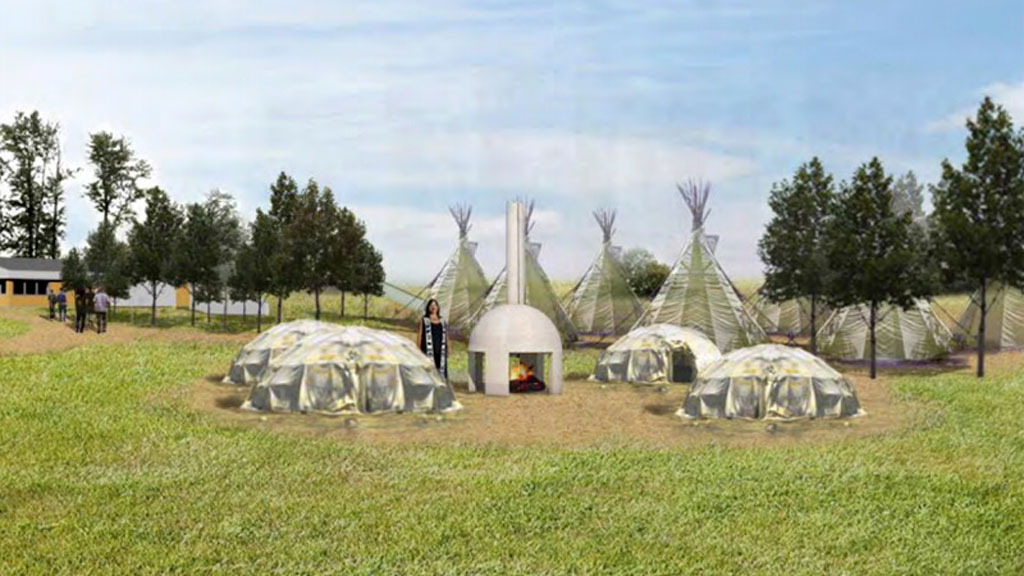Crews in Edmonton have begun work on the kihciy askiy site where the first permanent, urban Indigenous ceremonial site in Canada will be built.
Officials stated the facility will help Indigenous people in the capital region host spiritual ceremonies, sweat lodges, cultural camps and talking circles. The site will also be used for growing medicinal herbs and conducting intergenerational learning.
Construction will take approximately 18 to 24 months.
Nav Sandhu, program manager, and Chelsea Burden, project manager for facility infrastructure delivery for the city, explained the origin of the project and what it means for the community.
How did this project come about?
The city had heard from Indigenous Elders, community members and leadership that access to ceremony, cultural activities and land-based learning in the city is limited. kihciy askiy will be a safe place for the Indigenous community and non-Indigenous people alike to access cultural teachings in an inclusive space. In addition, transportation and costs can serve as barriers to leaving the city for ceremony and land-based learning. kihciy askiy-Sacred Land could offer a space in a natural setting for ceremonies and land-based learning to take place in the heart of the city.
What was the process like planning the project?
This project began in 2006 when the city received a proposal from the Edmonton Indigenous Cultural Resource Counsel to create a permanent site for Indigenous cultural events and learning experiences for both Indigenous and non-Indigenous people. In 2009, the Whitemud Integrated Area Concept Plan was amended to include the development of kihciy askiy and in 2011 city council approved funding for design and the first phase of construction.
In 2015 and 2018, Native Counselling Services of Alberta hosted a Grand Council Gathering for Indigenous Spiritual Leaders living in the Capital Region where the kihciy askiy concept design was reviewed and approved. Also during this gathering, attendees discussed protocols to be used for ceremony and developed an understanding of the ceremonial and spiritual needs of the Indigenous community in the Capital Region. Native Counselling Services of Alberta also created the Counsel of Elders to guide the Project Team during the design and construction of kihciy askiy, who continue to meet and provide spiritual and cultural leadership for the project.
Lastly, in 2020, the city began working with the Indigenous Knowledge and Wisdom Centre (IKWC). With continuing guidance from the kihciy askiy Counsel of Elders, IKWC will undertake the work of completing the governance and operation model and engaging with community partners.
What does the construction of the project entail?
Initially, the kihciy askiy-Sacred Land cultural site will feature a circular area for four sweat lodges and a permanent ceremonial stone heating device with a water source, as well as a circular area for tipis with a permanent feast fire pit for ceremonies.
It will also include spaces for small group workshops, a large tent and tipi gathering area for ceremonial feasts and cultural teachings, and the kihciy askiy pavilion with washrooms, locker rooms, a gathering room and storage for ceremonial items. There will also be a widened access road, parking stalls for cars and buses and a turnaround for emergency response vehicles.
What sort of special considerations need to be made for a unique project like this?
Not only will it be the first urban Indigenous ceremonial site in Canada, it also features a unique partnership with the IKWC and the Indigenous community who championed this project for many years and ensured it will become a reality.
There are both large and small considerations. For example, instead of hosting a groundbreaking event to signify the start of construction, project Elders held a ground blessing event where representatives from the city, construction partners, architect partners, as well as the Indigenous community and project partners from IKWC sought blessing from Mother Earth to allow construction to take place at the site. Things like language are also looked at closely. For example, kihciy askiy is Cree for “Sacred Land,” and is always spelled lowercase as the Cree language has no capital letters.
The city project team received a request from the project Elders Counsel to find ways to ensure Indigenous workers or Indigenous-owned businesses could participate in the construction of the site. When the city was selecting its construction manager for the project, the evaluation criteria included a social component that referenced the company’s corporate approach to Indigenous relations and how the inclusion of Indigenous people and businesses will be incorporated into the project.
What does it mean to be one of the first cities to have a project like this?
kihciy askiy represents a unique opportunity for the city to take meaningful action toward reconciliation by creating spaces for ceremony and land-based learning in a natural, transit-accessible setting in the heart of Edmonton. The city is honoured to play a role, along with the IKWC and the kihciy askiy Elders Counsel, in bringing this unique project to life.
Follow the author on Twitter @RussellReports.











Will there be visiting elders and story tellers.from other places .? To share.
How does one get involved